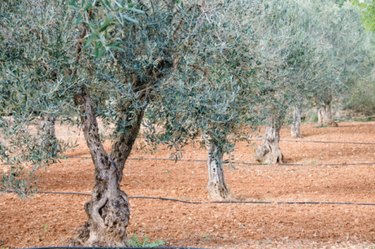
Man has cultivated olive trees for thousands of years, and the tree is featured in many legends and mythological tales. The trees are native to the warm Mediterranean region and may be grown indoors in cooler areas. Olive trees produce olive fruits, which have many culinary uses. Like most fruit-producing plants, olive tree flowers must be pollinated before their fruits can grow.
Propagation
Video of the Day
Olive trees cannot be grown from seed. Grafting may be used to create new trees, but a much easier method is to take cuttings from healthy, established trees. Cuttings should be 12 to 14 inches in length, taken from wood that's two years old. Newly planted cuttings will not produce fruit for about four years, but they should bear fruit annually after this. Proper propagation and cultivation of olive trees is necessary if you want your trees to produce healthy, edible fruit.
Video of the Day
Pollination
Flowers of the olive tree, which are small and whitish, are difficult to see behind the evergreen leaves. Olive trees produce both perfect flowers, with male and female reproductive organs, and staminates that contain only stamens. Olive trees do not need insects for pollination, only wind, and most varieties are self-pollinating. Cross-pollination, the practice of planting more than one olive tree to ensure pollination, is not necessary but it does produce more desirable fruit.
Temperature
In addition to pollination, temperature plays the biggest role in olive tree fruit production. The tree will not start growing until temperatures warm to 70 degrees F. Once temperatures fall below 70 degrees F, growth stops. Flowers only begin to grow when the tree experiences cool nights and warm days. Nights cannot be too cool, however -- buds will freeze if exposed to temperatures below 17 degrees F. If temperatures fall below 10 degrees F, the tree may die completely. If flowers do not grow because of inadequate temperature conditions, or become damaged in freezing weather, pollination is no longer a factor because the blooms will not produce fruits anyway.
Fruit
Olive fruits are produced from pollinated blossoms. Initially, olive fruits are green. Some varieties stay green even after ripening, while others turn dark purple or brown. Flowers that are not pollinated, and even on the healthiest trees not all flowers will be, simply wilt and drop off the tree. Olive tree fruit may be damaged by cold weather and should be harvested before fall frosts.